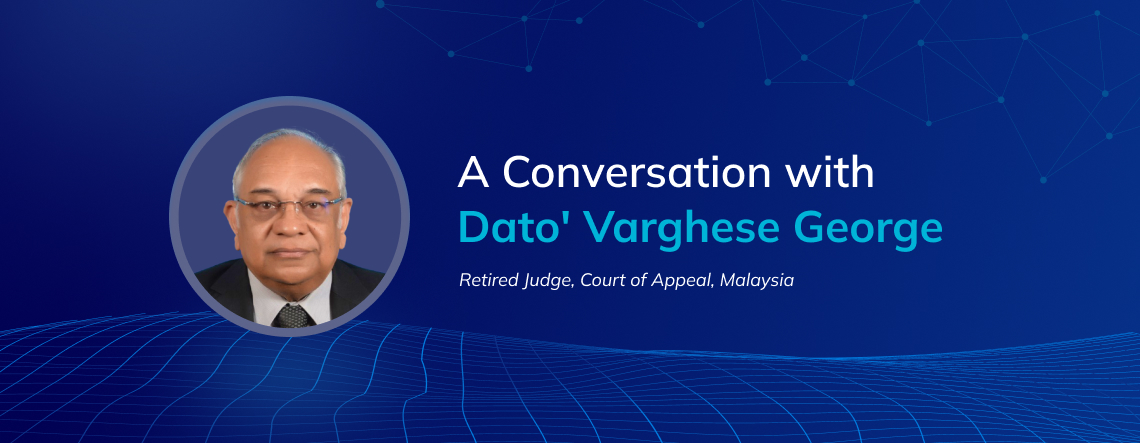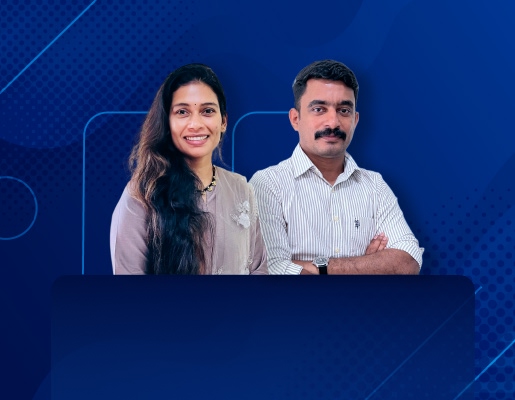Dive into a compelling discussion with Dato’ Varghese George, where he unpacks the evolving role of technology in legal practice and dispute resolution. Bridging the traditional and modern legal landscapes with ease, he provides insights that shed light on how practitioners can navigate this transformation, and how the profession can remain not just efficient, but also equitable and forward-thinking.
Overview :
The Evolution of Legal Tech: A Conversation with Dato’ Varghese George
-

Vani Sriranganayaki
-
-
Feb 27, 2025
-
14 min Read
-

Introduction
As technology continues to transform legal practice, the ability to navigate this shift becomes critical. Traditional courtrooms are being supplemented – and in some cases, replaced – by virtual hearings, digital case bundling, and automated contract management systems. Law firms, corporate legal departments, and even judicial bodies are investing in tools that enhance efficiency, reduce backlogs, and improve decision-making processes.
At the crossroads of legal tradition and technological transformation stands Dato’ Varghese George – a distinguished retired judge of the Malaysian Court of Appeal and a trailblazer in the evolving world of ADR. With decades of experience across litigation, the judiciary, and alternative dispute resolution, he has had a front-row seat to the digital revolution reshaping the legal industry. From his 35 years as a litigator at Messrs Zain & Co to his tenure on the Bench, both at the High Court of Malaya, and the Malaysian Court of Appeal, to his advocacy for ADR, his journey offers a rare blend of deep-rooted legal expertise and forward-thinking insight. His experiences position him at the forefront of discussions on how technology can support, rather than disrupt, legal processes.
One of the most pressing conversations in legal technology today revolves around balancing innovation with traditional legal principles. While automation and AI-driven legal tools offer significant efficiencies, they also raise questions about fairness, transparency, and ethical considerations. How do we ensure that justice remains impartial in a world increasingly influenced by algorithms? How do practitioners, arbitrators, and legal institutions retain the integrity of legal processes while adopting technological efficiencies? These are critical discussions that require the insight of seasoned legal minds who have not only observed these transformations but have actively contributed to shaping them.
Dato’ Varghese George is one such figure whose expertise bridges both the traditional and modern legal landscapes. Since retiring from the Bench in 2017, he has dived headfirst into ADR, serving as an Arbitrator, Adjudicator, and accredited Mediator in both domestic and international proceedings. As a practitioner who has seamlessly transitioned from the judiciary to ADR, he brings a unique perspective on the practical applications of legal tech within dispute resolution. His insights offer invaluable guidance on how legal professionals can leverage technology without compromising the core values of justice.
In this exclusive interview, we explore the evolving role of legal technology through the lens of a distinguished jurist and ADR expert. As Dato’ Varghese George shares his experiences, observations, and thoughts on the future of legal practice, his words serve as both a reflection on past transformations and a guidepost for the future. His perspective is especially pertinent at a time when legal practitioners, judicial bodies, and tech innovators must collaborate to create a legal ecosystem that is both technologically advanced and fundamentally just.
Excerpts from the interview
Looking back at your time on the Bench, how did technology influence the way courts operated during your tenure?
I was only on the Bench for seven and a half years between the end of 2009 and early 2017 (after 35 years as a litigator in the courts, tribunals, etc.). Yes, during that time, we did benefit from technological and digital advancements, such as the availability of video recordings of proceedings, edited transcripts accessible within a few days of the conclusion of proceedings, demonstrative aids with projections on mounted common screens in the courtroom (as opposed to individual computer screens for each judge and lawyer these days), storage devices like thumb drives, and so on.
In recent years, we have seen a rapid shift toward digitalisation in the legal system. What, in your view, has been the most significant technological advancement in the judiciary?
Post-Covid, the most significant change in the judiciary, I would say, has been the widespread embrace of videoconferencing for case management hearings and, notably, online virtual hearings (often termed ‘Zoom hearings’), displacing the physical courtroom dramas we are all too familiar with. Going hand in hand with this was the acceptance by both the courts and lawyers of ‘written’ submissions, and legal precedents being presented and transmitted to the courts digitally, eliminating the need for handling voluminous physical bundles of pleadings, submissions, and authorities – saving paper, reducing storage requirements in judges’ chambers and court registries, and making legal processes more efficient.
While technology has improved access to justice, it also presents challenges. What are some key concerns that courts and legal professionals should be mindful of as they embrace digital transformation?
In my assessment, the technological advances I have adverted to above might be advantageous for the efficient handling of cases and the saving of time and space, etc., in the administration of justice at appellate levels and perhaps in commercial/civil disputes. However, we should be mindful that they might compromise the extent to which justice is upheld and dispensed, and its appearance of being done fairly and impartially, at the first instance of hearings – especially in criminal trials and complex civil/commercial disputes, where assessing the demeanour of witnesses is one of the paramount duties of the judge/arbiter.
In other words, this is a basic right that any party or accused person requires from the judge/arbiter, and the danger is that it might be lost or pushed to the shadows in an online or virtual hearing (that is, without physical eye-to-eye contact with the witnesses). The aura of the surroundings and the setting of a physical courtroom remain essential components of the visual and tangible affirmation of the administration and dispensation of justice to the citizen.
From virtual hearings to AI-driven legal research, how do you think technology has changed the role of judges and lawyers in decision-making?
There is so much out there, as it is said, for you to click and have access to. However, what should put practitioners and judges equally on guard is that while some material is helpful, there is also content that is ‘fake,’ misleading, or even contrived to achieve one’s argument. What is now demanded of a judge or practitioner is another level of discernment – to differentiate between them and have the integrity to exclude the doubtful ones.
ADR, particularly arbitration and mediation, has also seen a shift toward digital platforms. How do you see technology shaping the future of ADR, and what are the key advantages or challenges in moving toward fully digital dispute resolution?
Here arbitration should be separated from mediation. I might be conservative here, but for mediation I think an on-site mutual physical attendance and evaluation by the mediator is a very important aspect of the process itself. On the other hand, for arbitration, especially international ones, involving parties or arbitrators who are located in different places or countries, the evolving tools for digital dispute resolution are definitely advantageous and will increasingly become the norm if they have not already.
For young legal professionals entering the industry today, how important is tech literacy, and what advice would you give them to stay ahead in a rapidly evolving legal landscape?
Absolutely important. It is their lifeblood so to speak. It is obvious that skills in oral advocacy for a litigator are gradually being displaced by technological skills. A legal professional today must be educated in utilising a vast array of tools and applications available to effectively make their case. So, young legal professionals therefore, apart from devoting time to stay updated on current legal developments, both legislative and via court decisions, must also spend time upskilling their technological prowess to be an impactful lawyer for their clients.
Finally, if you could implement one technological change during your time as a judge that was not available then, what would it be and why?
This would surely involve having a ‘live’ or instantaneous transcript of proceedings available during trials or hearings. Corrections and amendments could be made (both by Judges and lawyers) as the proceedings continue or at convenient intervals. Although with delayed transcripts, Judges were spared from taking down accurate and copious notes of proceedings, I had, during my time on the Bench, the habit of making personal notes of salient aspects of evidence/submissions as a safeguard. I have carried this practice into my role as an independent arbitrator now.
A settled Notes of Proceedings at the close of each day’s proceedings is indeed something that a Judge or Arbitrator should look forward to.
-
Topics:
-

-
Vani Sriranganayaki
Writer, editor, and Head of Communications, Vani brings over a decade of expertise in publication and communication to explore the evolving world of technology. She crafts impactful narratives at the intersection of legal innovation and tech, championing progress. Reach her at vani.s@elint.in.

 +971 50 9295048
+971 50 9295048  +91 9746059514
+91 9746059514